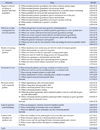Abstract
Purpose
This study examined the knowledge and perception of hospice-palliative care and terminal care stress among pediatric nurses, and the relationships among these variables.
Methods
In this descriptive research study, 154 pediatric nurses who experienced terminal care at least once were surveyed. This study used three scales, including the Palliative Care Quiz for Nursing (PCQN), Perception of Hospice-Palliative Care, and Terminal care stress. Data analyses using SPSS 22.0 included descriptive statistics, independent t-test, one-way ANOVA, Mann-Whitney U test, Pearson's correlation coefficient, and stepwise multiple linear regression.
Figures and Tables
References
1. Kang KA, Kim SJ. The present and future of children's hospice care in Korea. Korean J Child Health Nurs. 2003; 04. 9(2):190–197.
2. Wi DH, Kang SJ. Relationship among nurses' knowledge, attitude towards palliative care and perception of death in neonatal intensive care units. Child Health Nursing Research. 2016; 10. 22(4):257–264.

3. Nambayan AG. Palliative care: opportunities for nursing. Asia Pac J Oncol Nurs. 2018; Jan-Mar. 5(1):1–3.
4. Pesut B, Greig M. Resources for educating, training, and mentoring nurses and unregulated nursing care providers in palliative care: a review and expert consultation. J Palliat Med. 2018; 01. 21(S1):S50–S56. DOI: 10.1089/jpm.2017.0395.

5. Haut CM, Michael M, Moloney-Harmon P. Implementing a program to improve pediatric and pediatric ICU nurses' knowledge of and attitudes toward palliative care. J Hosp Palliat Nurs. 2012; Jan-Feb. 14(1):71–79. DOI: 10.1097/NJH.0b013e318236df44.

6. Morgan D. Caring for dying children: assessing the needs of the pediatric palliative care nurse. Pediatr Nurs. 2009; Mar-Apr. 35(2):86–90.
7. Kim JH. The job stress, perception, and training needs on the end-of-life care among cancer unit nurses [master's thesis]. Seoul: Yonsei University;2009. 51.
8. Jang SH. Neonatal intensive care unit nurses' stress of end-of-life care for high-risk newborn [master's thesis]. Seoul: Ewha Womans University;2013. 59.
9. Ji SI. Factors which affect nurses' stress from terminal care [master's thesis]. Gwangju (Korea): Chonnam National University;2012. 51.
10. Kang KA, Kim SJ, Kim YS. The need for child hospice care in families of children with cancer. Korean J Hosp Palliat Care. 2004; 12. 7(2):221–231.
11. Yu J, Bang KS. Pediatric nurses' perception and knowledge about pediatric hospice palliative care. Korean J Hosp Palliat Care. 2015; 09. 18(3):235–244. DOI: 10.14475/kjhpc.2015.18.3.235.

12. Swinney R, Yin L, Lee A, Rubin D, Anderson C. The role of support staff in pediatric palliative care: Their perceptions, training, and available resources. J Palliat Care. 2007; 03. 23(1):44–50. DOI: 10.1177/082585970702300107.

13. Davies B, Sehring SA, Partridge JC, Cooper BA, Hughes A, Philp JC, et al. Barriers to palliative care for children: perceptions of pediatric health care providers. Pediatrics. 2008; 02. 121(2):282–288. DOI: 10.1542/peds.2006-3153.

14. Kim GH. The perception of hospice palliative care and terminal care attitude of nurses at long-term care hospitals [master's thesis]. Busan (Korea): Catholic University of Pusan;2016. 55.
15. Jang JY. Hospice care stress and death awareness of general ward nurses [master's thesis]. Seoul: Hanyang University;2016. 55.
16. Jun JS. Spiritual well-being, attitude towards death and perception of hospice among nurses [master's thesis]. Busan (Korea): Catholic University of Pusan;2014. 55.
17. Ross MM, McDonald B, McGuinness J. The palliative care quiz for nursing (PCQN): the development of an instrument to measure nurses' knowledge of palliative care. J Adv Nurs. 1996; 01. 23(1):126–137.

18. Kim HS, Kim BH, Yu SJ, Kim S, Park SH, Choi S, et al. The effect of an end-of-life nursing education consortium course on nurses' knowledge of hospice and palliative care in Korea. J Hosp Palliat Nurs. 2011; Jul-Aug. 13(4):222–229. DOI: 10.1097/NJH.0b013e318210fdec.

19. Kim MS. Comparison on the perception about hospice and the meaning of life of participants and non-participants of the hospice volunteer education program [master's thesis]. Gwangju (Korea): Chonnam National University;2007. 60.
20. Lee YO. A study of cancer unit nurses' stress from bereavement support [master's thesis]. Seoul: Kyung Hee University;2004. 64.
21. Knapp CA, Madden V, Wang H, Kassing K, Curtis C, Sloyer P, et al. Paediatric nurses' knowledge of palliative care in Florida: a quantitative study. Int J Palliat Nurs. 2009; 09. 15(9):432–439. DOI: 10.12968/ijpn.2009.15.9.44255.

22. Knapp CA, Shenkman EA, Marcu MI, Madden VL, Terza JV. Pediatric palliative care: describing hospice users and identifying factors that affect hospice expenditures. J Palliat Med. 2009; 03. 12(3):223–229. DOI: 10.1089/jpm.2008.0248.

23. Knapp CA, Thompson LA, Vogel WB, Madden VL, Shenkman EA. Developing a pediatric palliative care program: addressing the lack of baseline expenditure information. Am J Hosp Palliat Care. 2009; Feb-Mar. 26(1):40–46. DOI: 10.1177/1049909108327025.

24. Kim KS. The relationship among perception of death, end-oflife care stress and end-of-life care attitude of nurses [master's thesis]. Busan (Korea): Kosin University;2016. 61.
25. Pereira SM, Fonseca AM, Carvalho AS. Burnout in palliative care: a systematic review. Nurs Ethics. 2011; 05. 18(3):317–326. DOI: 10.1177/0969733011398092.

26. Kim WS, Cho HH, Kwon S. The influence of terminal care performance, death anxiety and self-esteem on terminal care stress of geriatric hospital nurses. Korean J Hosp Palliat Care. 2016; 06. 19(2):154–162. DOI: 10.14475/kjhpc.2016.19.2.154.

27. Kim MG. Burnout experienced by nurses in the hospice palliative care unit [master's thesis]. Seoul: Kookmin University;2016. 135.




 PDF
PDF ePub
ePub Citation
Citation Print
Print








 XML Download
XML Download